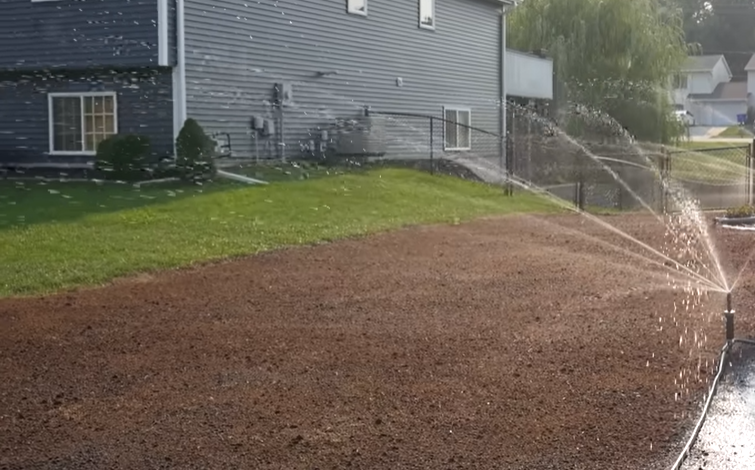Establishing a new lawn from seeds does require extra care and attention to achieve lush grass. The seeds require adequate water to germinate properly and develop the root. Many gardeners ask this question; how often do I need to water grass seeds?
It’s essential to water the soil for about 6 to 8 inches a few days before planting grass seeds. Water again for about 2 inches after planting the seed. Water twice daily for 3 to 4 weeks until the seeds germinate.
However, weather conditions such as rainfall and temperature can also determine how often you need to water your grass seeds. Straw over grass seed can help conserve soil moisture.
How often do I Need to Water Grass Seed?
It’s important to water your seeded lawn regularly to encourage germination. Water is among the necessary conditions required by grass seeds to germinate. Here is how to water grass seed the right way:
Water before seeding
Several days before planting your seeds, water the area to a depth of 6 to 8 inches. It helps to create hospitable conditions for the incoming new seeds. You can also incorporate little compost into the soil during this period to make it richer. Allow the area to dry partially before spreading your seed.
So, how do you know that you have watered 8 inches into the soil? It is easy to measure the depth of water infiltration into the soil. You simply use a long screwdriver. Insert it into the soil; it should be able to push easily to a depth of 8 inches. If there is some resistance, you must water the soil appropriately.
Water immediately after seeding
Immediately after spreading the seeds on the soil, water them up to a depth of 2 inches or for about 5 to 10 minutes. The seeds may dry out if they are not watered after planting. Water the seeds whenever the soil becomes dry. Dip your index finger into the soil to check the moisture content. If the soil feels dry, it’s time to water.
When watering, be sure not to over-water. Overwatering grass seed excessively puts it at risk of being washed away or floating into clumps. It also encourages bare spots, seeds sticking to muddy shoes when moving the sprinkler, and trails of footprints in the dirt.
Water after Germination
When the grass seeds germinate, they develop roots and require adequate water to keep them growing. For a month, you have to check your lawn regularly and water it lightly whenever the soil feels dry. It is recommended to water lightly twice daily or more, depending on weather conditions.
During the dry season, pay more attention to sun-soaked areas than shaded areas. Be sure not to over-water newly germinated seeds, as it can affect the development of roots.
Reduce watering when grass establish
Once your new lawn is established, it’s time to reduce the water and frequency of watering. Generally, giving your lawn an inch of water once per week is good to keep them going. It encourages the grass to develop deeper roots in the ground and get more tolerant to drought.
However, this process needs to be gradual. For instance, if you water your lawn twice a day, it can be reduced to once for a few days, then twice per week, and finally once every 7 days.

Missed a Day of Watering Grass Seed?
It’s important to water a newly seeded lawn daily. Water is essential during this stage of development. Water, air, and warmth are necessary conditions for the germination process to take place. Missing a day of watering is a major setback to establishing your new lawn.
Missing a day of watering grass seeds will not definitely kill them. However, it may halt the process of germination. You may end up with uneven germination. Grass seeds require ideal conditions to germinate uniformly.
If you forgot to water your seeded lawn, do it immediately the moment you remember.
To remember, you set the alarm on your phone to remind you of the watering schedule, use a timed sprinkler or irrigation system, fix a timer on the garden horse, or hire the task out to a lawn care company.
How Long can Grass Seed go Without being Watered?
A newly seeded lawn can survive a day or two without water; beyond that, some seeds may die. The following tips will help in conserving soil moisture for maximum seed germination.
1. Cover the seeded area with mulch
Immediately after planting your seeds, cover the soil with mulch before watering. Straws are the best materials for mulching your seeded area. Mulching helps conserve soil moisture, stops birds from eating grass seed, and protects the seeds from being carried away by winds or water.
2. Avoid sowing the seeds in the hottest season
It’s not ideal sowing your grass seed in the year’s hottest season. High summer temperatures increase the rate of evaporation. Therefore, the soil is likely to dry out fast. However, if you have no choice, be sure to water your lawn deeply and frequently.
3. Do not use cheap sprinklers
Most cheap sprinklers in the market do not distribute water evenly. Some may leak to cause puddles in your lawn. It’s always said that cheap is expensive. You may be happy that you have obtained a sprinkler at a cheaper price, but you end up with a ruined lawn. Oscillating sprinklers are the best choice for a new lawn.
Final Thoughts
Generally, it is ideal for watering your new lawn twice a day for about 5 to 10 minutes. Early in the morning and late in the afternoon to reduce the rate of evaporation.
It’s also recommended to water late afternoon and not in the evening. It gives the grass blades ample time to dry out before nightfall. Watering late in the evening can promote the growth of fungal infections.